Athens, capital of Greece and birthplace of democracy. It is in this city that as early as 5th century BC, voting systems were in place and the people had a say in who ran the government. Though there are other places in the world that have an earlier history of types of democracy, Greece is from where the Romans picked up this idea, and modern day western society got many ideas from both the Greeks and Romans. In modern day Athens, you can go visit the Acropolis, the ruins of the city center of this once grand government, and imagine what these roots of democracy looked like, 2500 years ago.
When we were planning our trip to Athens, most of what we read on the city said to spend a short time there. We heard that other parts of Greece are far more beautiful and scattered with other ancient ruins that would not disappoint. From our experience, this turned out to be true. Though Athens is certainly worth a visit to see the center of modern and Ancient Greece, as you will see in the next blog, the countryside of the country is unbelievably beautiful, with a charm and history all it’s own – not to mention some gorgeous beaches. Ultimately, we spent five days in Athens, less than a third of our full time in Greece, which gave us plenty of time to leisurely view the ruins and findings of this ancient capital.
As you can imagine, being the capital city of a once grand city state, Athens is home to a myriad of ruins, museums, and well, more ruins. Like Rome, Athens has had a difficult time developing their subway/metro systems, because every time they start digging, more ruins are found. To be honest, for me, the more ruins we saw, the more they all started looking the same, but even in their sameness, the importance of individual sites was still quite grand. For example, standing next to systems of the court of this old democratic system blew me away just as much as walking around the site of Aristotle’s school, but most everything you see is basically just old stone that has stood an enormous test of time (no small feat, but it doesn’t keep it all from looking similar). All that to say, a lot of the pictures below might end up looking pretty similar, especially via the Internet, but the grandness felt from actually standing in these places is entirely different than what a photo can capture. Perhaps the descriptions can help bring some of the grandness to light.
Before continuing I think a brief history is in order to give a little context to some of the ruins pictured below. This won’t do the actual history of Greece justice, but it will give a little context and timeline for the photos to come.
Though there is evidence of people (farmers) living in Greece as early as 7000 BC, and evidence of a city state (Mycenae) being formed around 1600 BC, city states like Athens and Sparta were put together by around 800 BC. For a long time, Greek city states ruled themselves, sometimes fighting amongst each other, but ultimately maintaining an overarching “Greek” culture. 5th and 4th century BC was the Greek prime – when philosophy, arts, sciences – many things that influence our modern day culture and thought systems were growing (the end of this time period is when Alexander the Great came on the scene and really helped spread Greek culture, by conquering tons of people around them). By 86 BC, what we now know as Greece had been conquered by Romans and was apart of the Roman Empire. In 395 the Roman Empire split east and west – with Greece falling on the east side that became known as the Byzantine Empire (side note, the capital was Constantinople, modern day Istanbul). Eventually, (as you might remember if you read the Istanbul blog) the Byzantine empire fell to the the Turks and became apart of the Ottoman Empire in 1453. Greece was ruled by the Turks for a long time, but a growing nationalism lead to a Greek revolt, and after some help from the French, British, and Russians, Greece regained their independence in 1829.
There is a lot more history that could be talked about in the midst and end of that paragraph, but that should cover the periods in which most of the ruins below were built – after all, nearly all of them were built in either Greece’s prime (4th-5th century BC) or right after the Romans conquered them (1st century BC).
As far as what we saw, first stop, the less old, Parliament.

Parliament Building
Though this large building isn’t very old (built by 1842) it was originally a house for the monarch (they had a monarch for a bit after gaining their independence), and after the monarch was done away with, parliament was moved here. In front of the building is a “Tomb to an Unknown Soldier,” and much like the “Tomb of the Unknown Soldier” in the US in D.C., this one is guarded 24/7. The guards here switch every hour and we happened to be walking by when the crowd was gathering to watch them switch. The guards wear traditional outfits called foustanella, which are pretty interesting and seen below.

These outfits were worn by Greek revolutionaries who fought for independence against the Turkish between 1821 and 1829. I read that the skirts have 400 pleats which represent the 400 years that the Turkish ruled over them. Also, please note the Pom poms on the shoes. What interesting war outfits!
Though the parliament building was our first sighting in the city, it was only because we happened to pass it on the way to our first chosen destination, The Temple of Olympian Zeus.
This construction on this temple dedicated to Zeus began around 550 BC, but paused due to lack of funding. Though a few rulers over the years tried to work on it, this massive structure wasn’t given full attention and fully completed until around 650 years later, in 2nd century AD. Even crazier, after taking so long to be completed, the building was damaged in a war only around 100 years after it’s completion. That damage was never repaired, ultimately leading to the temple being in the shape it’s in now.
Of the original 104 columns, 16 remain on site and 15 of those remain standing. The 16th column fell in the 1850’s during a storm, and now that’s it’s down, it gives onlookers a clear picture of how these enormous columns were put together. Though only this small section remains of what was once the largest temple in Ancient Greece, these gigantic columns are still a sight to see, standing at 17 meters (55.5 feet) high and 2 meters (6.5 feet) in diameter.

Me, standing in front of the temple in attempt to show the size of the columns. This photo doesn’t do the sight of these things justice!
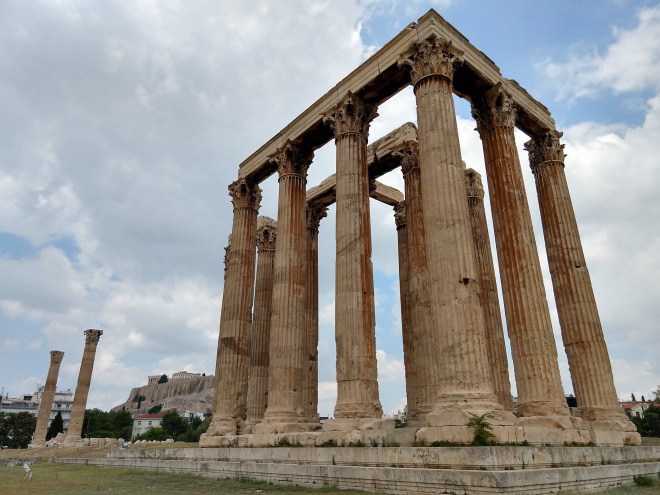
All that’s left of the temple, the city acropolis seen in the background between the sets of columns.
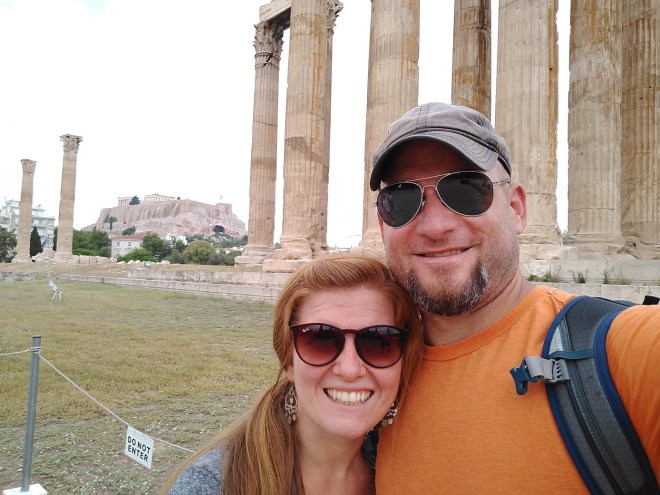
Selfie :)!
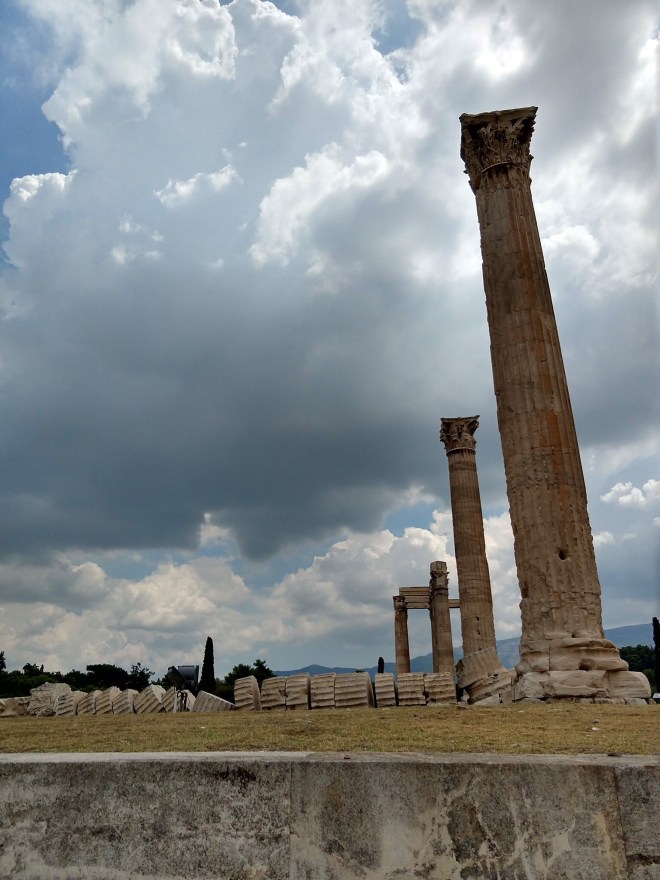
The fallen column. Note how many pieces were stacked to make up these giant structures! Also note, there is nothing in between the pieces – no rebar or steel running down the middle to keep them stacked (as we would likely have in modern times). Each column is like a tower a kid made from blocks – carefully stacked in hopes that it doesn’t tumble. These grown up kids certainly succeeded – their towers still stand 2000 years later!
Next to this temple of Zeus are some old Roman bath ruins – these would be from a later time period when Rome was ruling over Greece. The Romans LOVED their baths – old bath structures can be found all over the cities from the ancient world. From my understanding, these baths functioned somewhat like a mixture between a spa/hot springs and a community pool. They were cheap enough for an average person in society to be able to afford frequent visits and were the center of social life. The societies from these time periods had some pretty extensive terra-cotta plumbing systems alongside systems to heat the waters. Visiting a few of these baths, you are able to see where the pools once were alongside broken pieces of these old plumbing systems – pretty impressive.

Roman Baths
Also next to the Temple of Olympian Zeus is the Arch of Hadrian. This arch was built in 132 AD in honor of Emperor Hadrian of the Roman Empire. Emperor Hadrian was a well loved emperor who preferred to travel the empire and see things for himself, being among the people, rather than staying in his palace and allowing others to simply report what was happening to him. There are arches in cities all over the former Roman Empire commoratating and celebrating his visits.
Hadrian worked hard on uniting the kingdom, and one strategy he used to do this was through building projects. Many of his building projects were public spaces (like baths or temples) that everyone in a community was able to utilize and enjoy. He is the emperor under whom the Temple of Olympian Zeus was completed and there are an astounding number of large projects the were completed under his rule that are still standing (in whole or in part) today.
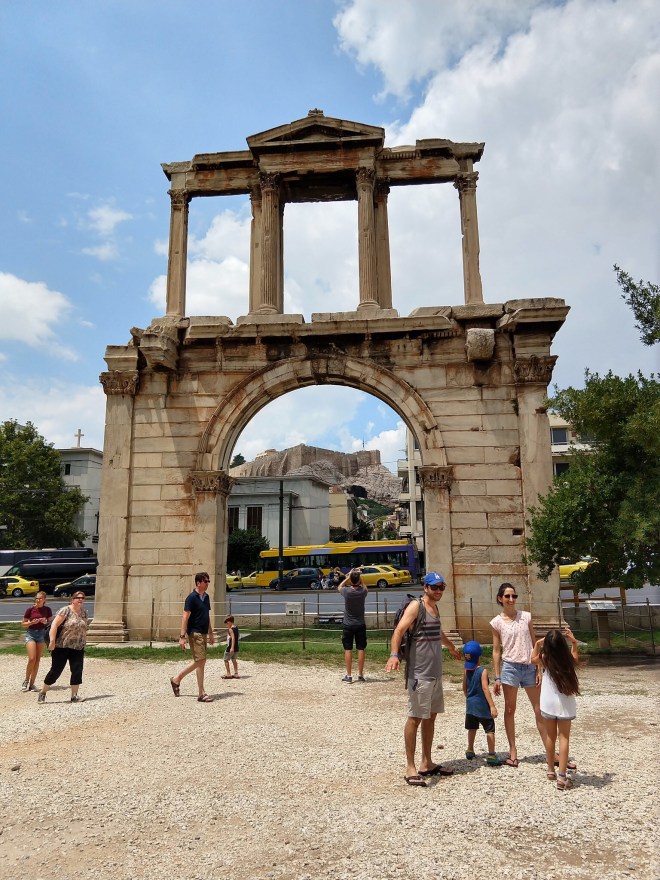
Hadrian’s Arch – 132 AD
Our second big sightseeing day in Athens, we headed to the infamous Acropolis. This city center of Ancient Greece sits on a hill high above the city, easily spotable from various parts of modern day Athens. Though evidence exists that people were living on this hill over 5000 years ago (4th millennia BC), most of the buildings still standing today were built in those years that Athens was at it’s prime – 2500 years ago. Though the very top of the Acropolis is the most famous area, home to the Parthenon, all around the Acropolis, on the slopes of the hill, are other ancient ruins. Photos are below.

Theater of Dionysos (god of wine) – 4th century BC-ish
The origins of theater are in Ancient Greece – plays and dramas that have ultimately turned into modern day film and television began right here. The above theater is on the site of the first known theater in the world. The Greeks built an initial theater here in 6th century BC, and what remains on the site today had it’s beginning in 4th century BC. Although theater shows would have already been taking place in Greece prior to the building of this enormous venue, this theater was the first of it’s kind – home to excellent acoustics and the capacity to seat 17,000 people.
Nearby the theater of Dionysus is another, better preserved theater by the name of Odeon of Herodes Atticus. With a seating capacity of 5,000 people, this theater was built in 161 AD (while the city was under Roman rule), around 600 years after the Theater of Dionysus. This theater has been restored and still hosts events today.
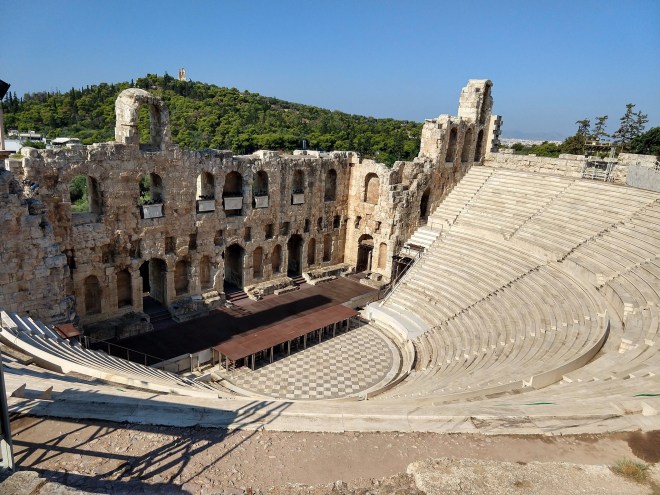
Odeon of Herodes Atticus Theater – 161 AD
After looking at the theaters on the Southern slopes of the acropolis, we headed to the main attraction, the top.

Walking up/in with the masses
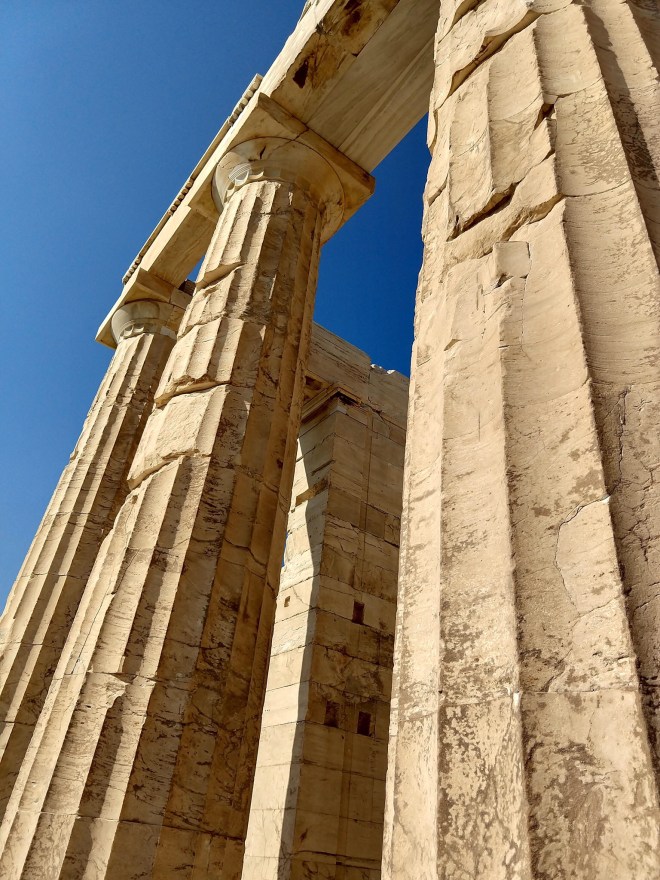
Up close photo of the initial columns of the propylaea (entrance) that welcomes you to the top of the Acropolis
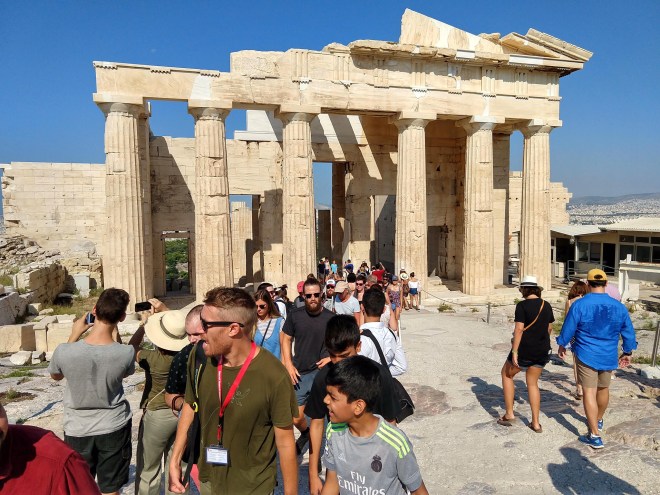
The view of the propylaea from the other side.
From the propylaea, its easy to glimpse the main attraction, the Parthenon.

The infamous Parthenon – completed in 438 BC
The Parthenon is a temple built to the goddess Athena that is a representation of Greek democracy at it’s prime. It’s considered the most important building from it’s time period, a symbol of the power Athens held. It was the largest building on the hill, easily seen from all around, a constant reminder of this wealth and power of the city.
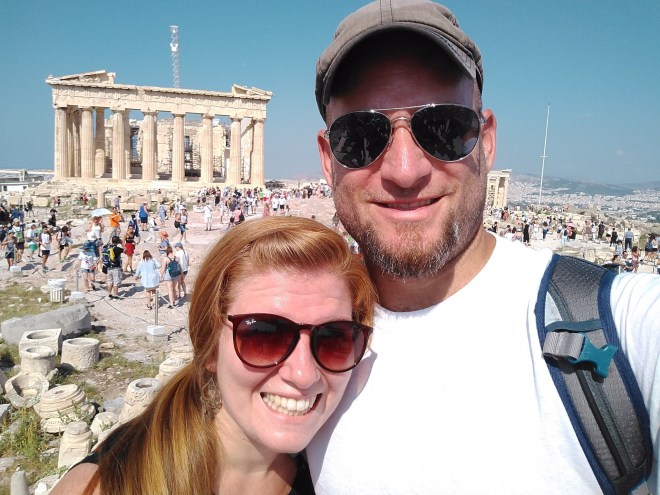
Selfie of us with the crowds in front of the Parthenon.
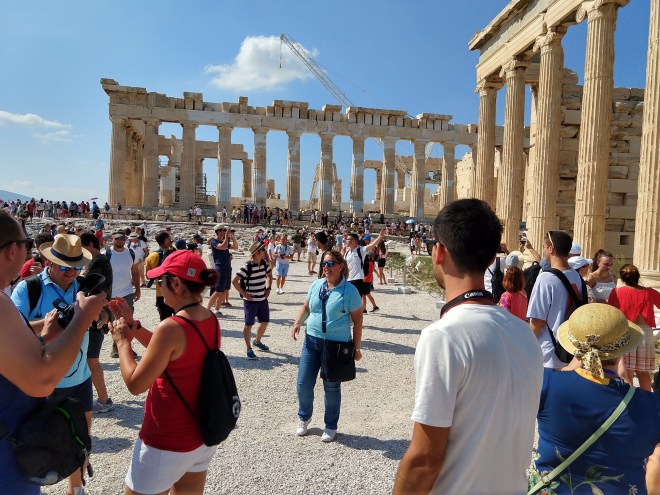
Though it’s not a great picture, I thought it gave a better reference of the size of the Parthenon. See how small the people next to it look! The columns to the right are apart of the Erechtheion.
Also apart of the Erechtheion is the below picture. The Erechtheion is a building built between 421-406 BC. It was home to the holy relics of that time – marks from Poseidon’s (god of the sea) trident, an olive tree grown by goddess Athena, and the burial place of several mythical kings.
(As a side note, it wasn’t until this trip that I put together that the old tales about gods that we now call mythology were the gods and goddesses worshipped by Ancient Greece and Rome. Or in other words – the gods and goddesses that the early church was telling people to turn away from were gods like Zeus and Apollo – familiar gods to us, but only in the context of mythology. Somehow, I hadn’t put together those familiar pieces until now!)
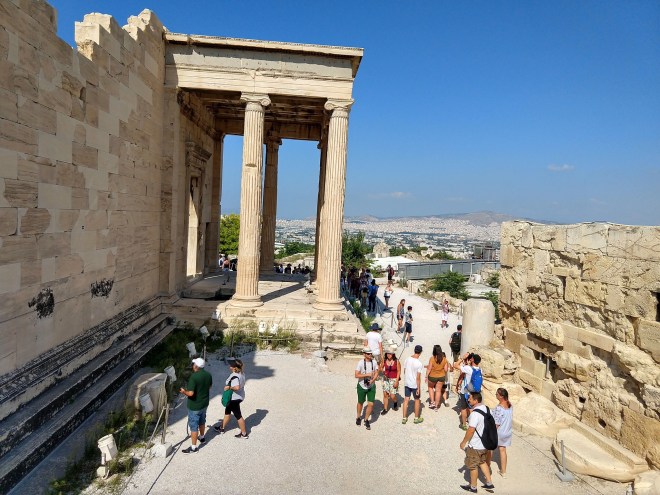
The Erechtheion – built 421-406 BC

Other side of the Erechtheion, with the few ruins of the old temple of Athena in front. My favorite sight on the hill was this back area of the Erechtheion. The statues used as columns for this small area of the building were majestic looking – far larger and more artistic than they appear in this picture.
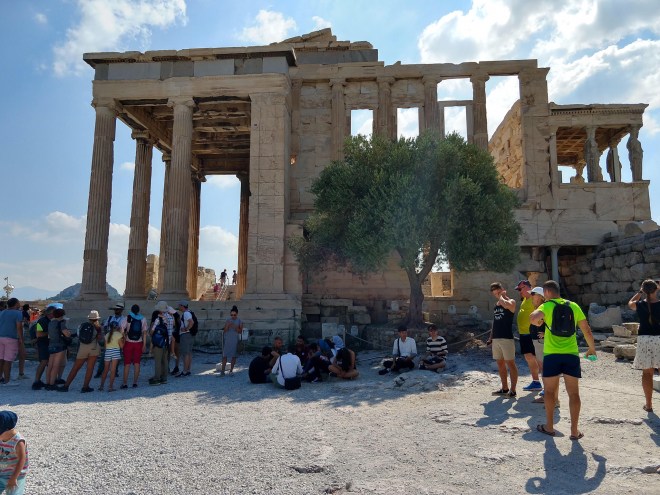
Side view of the Erechtheion
Though there are plenty of other ruins on the acropolis, the ones above are certainly the main attractions. Many of the others are quite literally in ruins, but still serve as a reminder of what once was. After spending some time on the top, we headed down for a final picture of this city center high on the hill.
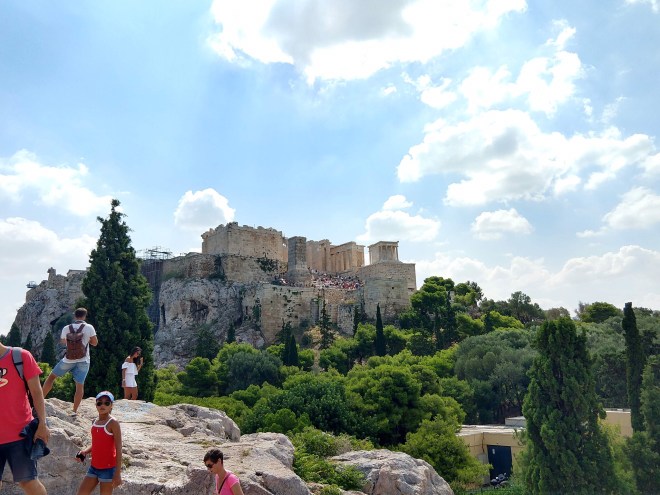
The Acropolis
The next place we visited was an area called the Roman Agora. This area was built in the 1st century under the command of Julius Caesar and Augustus. It was one of the centers of life in Athens during the Roman rule. It housed the marketplaces, so everyone had to stop by for their groceries – and there was even a public bathroom, with 68 seats still able to be seen.

View of one end of the Roman agora – the Tower of the Winds in front
The large intact structure seen above is known as the “Tower of the winds.” When it was originally built somewhere between 1st and 2nd century BC, it served as a type of clock, containing a sundial, a water clock (which I’ll tell more about later), and a wind vane. It was later turned into a church (as Christianity swept through the Roman Empire), and eventually, under the Turks, it became a place of prayer for whirling dervishes (see the Istanbul blog for more on Whirling Dervishes).
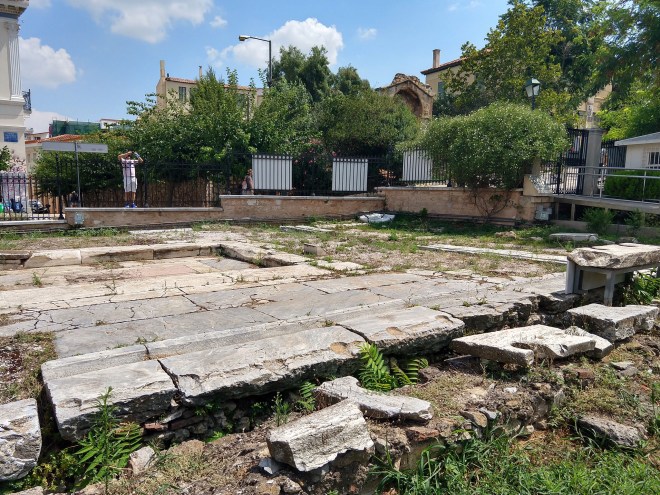
The public bathrooms. Every circle indention you see around the edge was a toilet. Though it’s probably hard to make out, the stacked blocks on the right show how the toilets would have been set up. They are quite close together, with no divider in between! In all, this small square had 68 “seats!”

A large section of the agora, where the market would have been. Not pictured, the entrance behind me that apparently has something ancient etched on it about an olive oil tax being implemented (though there was no way I could make out Ancient Greek 😂) – this was certainly the market place!
Across the street from the Roman Agora, a large section of an old building still stands that was once “Hadrian’s Library.” This library was named for the same well loved emperor who built many large structures for the people in the empire to utilize – this library was one of those structures. Built in 132 AD (the same year as Hadrian’s arch), the library once housed papyrus “books” (or rolls). Later, in 5th 7th, and 12th century AD, three separate churches were built on this site. Now, a single wall of the old library still stands with many pieces of the old churches scattered behind it.
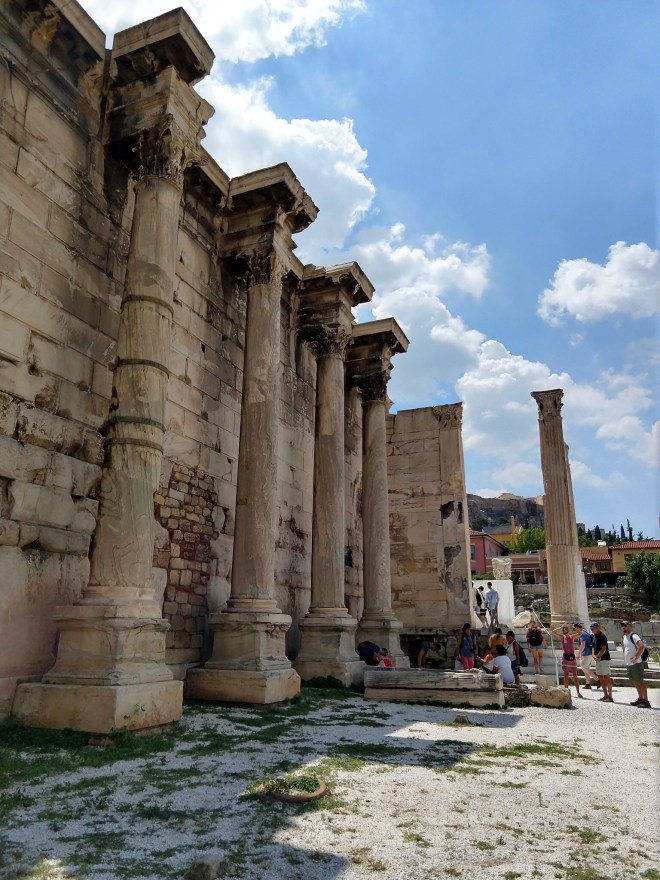
The single enormous wall of Hadrian’s Library that still stands from 132 AD
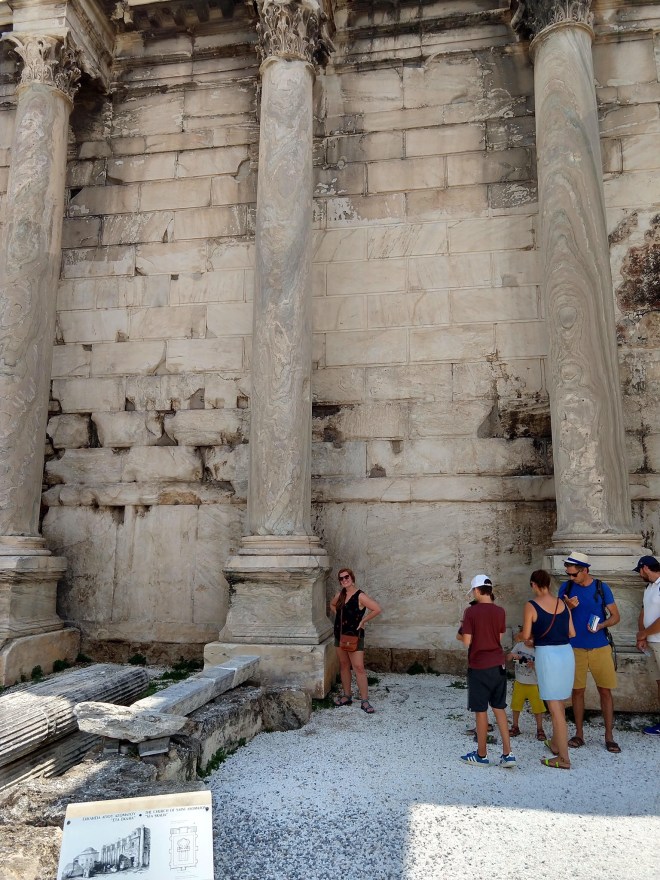
Me in front of the wall to give a better idea of how large these columns and wall are!
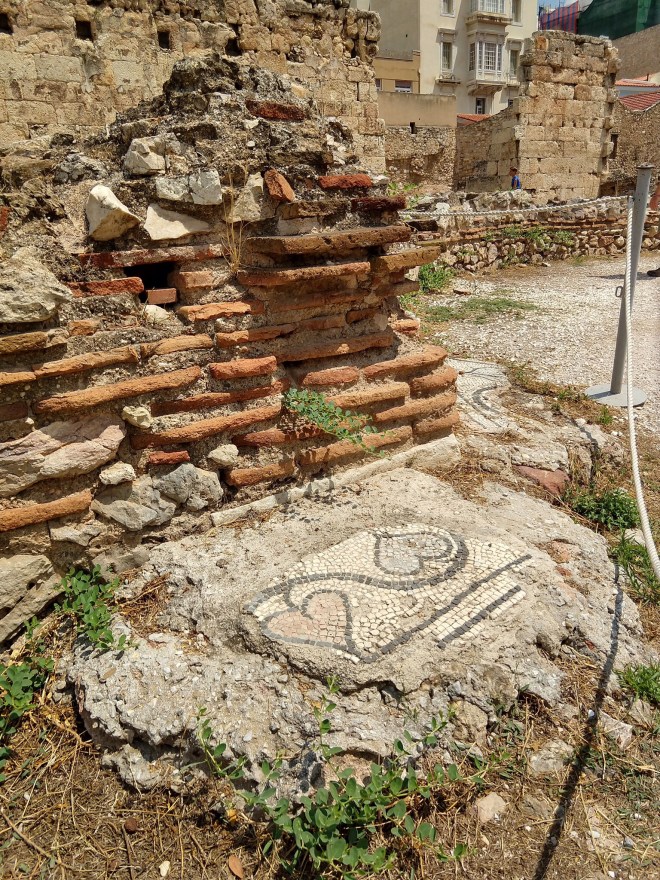
“Inside” the wall, a mosaic from a church

More ruins of one of the churches inside Hadrian’s Library
The next day we set off towards a nearby park that is home to ruins discovered in 1996. Walking in, you find a sign with a description of the area, calling this space “One of the most significant places in the history of humankind.” It sounds pretty extreme at first, but perhaps it’s at least in part true. These are the ruins of Lyceum – the school of Aristotle.
This is the location where Aristotle articulated his ideas about the world – logic, philosophy, ethos (morality), physics – passing it on to future generations, ultimately, on to us. Modern day scientific method developed here alongside types of inductive and deductive reasoning. Aristotle is said to have believed that facts are the starting point for all knowledge, so he sought to find ways to reach conclusions based on facts. Aristotle was the starting point for so much of what we know as truth in our world today. His thought systems changed and articulated how the world looked for truth, and that is a pretty big deal.
Honestly, as far as the actual ruins go, there isn’t really much at which to look. The ruins are small, but the significance of the area is enormous.
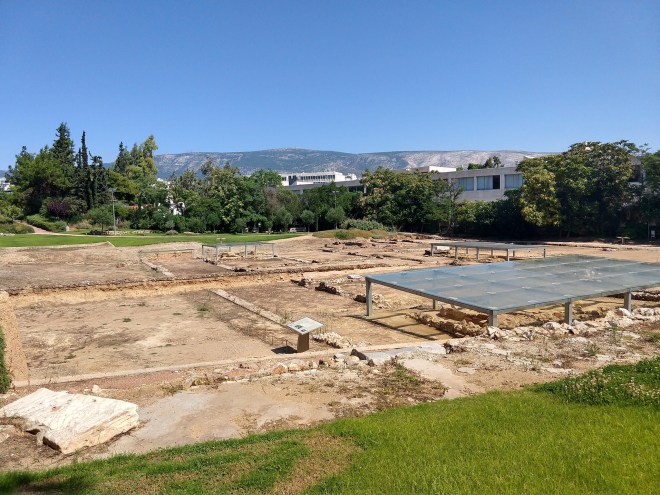
What’s left of Aristotle’s School – once fully equipped with a gymnasium and baths
The final place on our list of ruins to visit was the Ancient Agora. Though the Acropolis was the power symbol of Ancient Greece, this agora would have been the center of the life of the people – large market places, temples, civil offices, the state prison, gatherings – essentially, where all the business of the city happened. If the word agora sounds a little familiar, it’s because I already mentioned the Roman agora that we visited above. The ancient agora below is significantly older, larger, and more excavated than the Roman agora, and was possibly still in use when the Roman agora was built (that’s still a little unclear to me, but this is the more impressive of the two either way.)
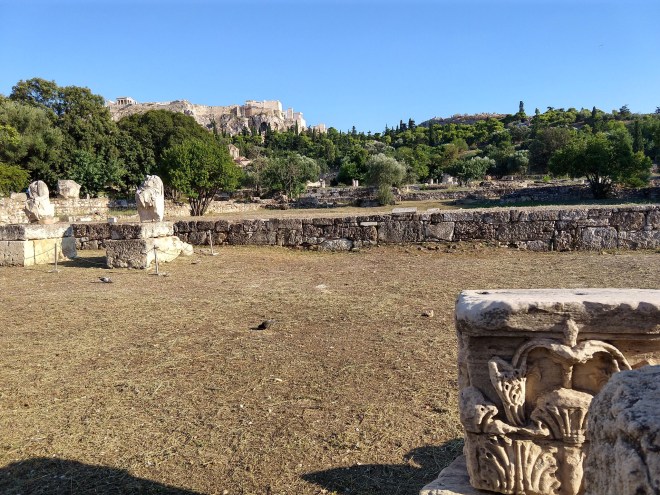
First sights of the ancient agora. Most of what once existed is no more, but this area is enormous.
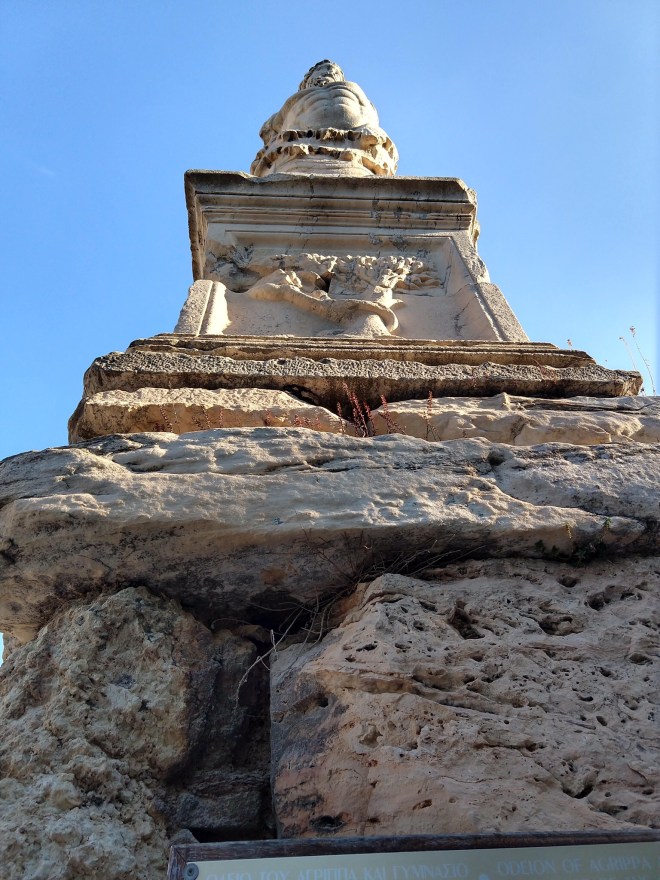
Enormous statues on pedestals greet you near the entrance.
Though most of this ancient agora has little left that has stood the long test of time, there is a single temple on the hill above it that happens to be the most intact ancient temple of the Greek world. This temple is the “Temple of Hephaestus.”
Built between 460-415 BC, this Temple of Hephaestus was eventually turned into a church, which ultimately preserved it’s structure. Prior to visiting this site, I had no idea that any structure this old was still fully standing. It’s pretty unbelievable!
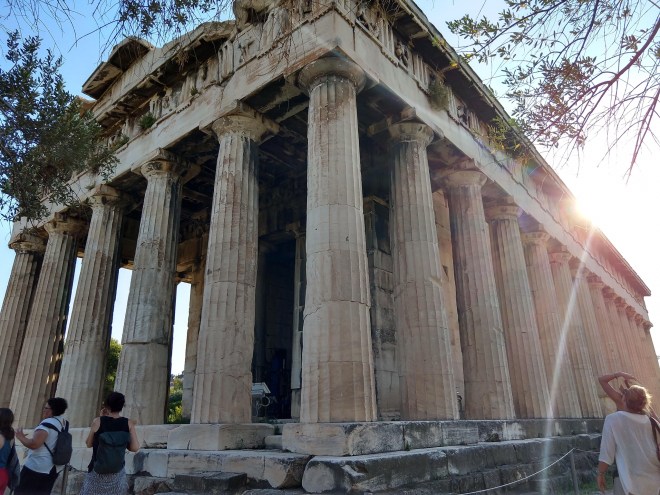
Temple of Hephaestus
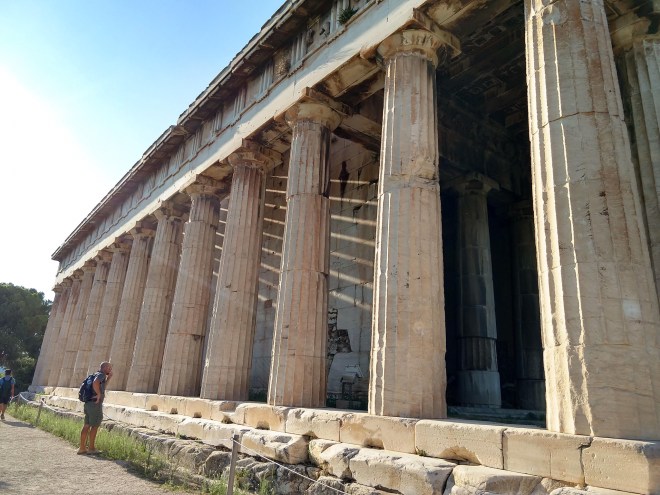
Kirk, next to the Temple of Hephaestus to give a better idea of it’s size

Temple of Hephaestus from father away, to give a better look. Y’all – that thing is nearly 2500 years old!
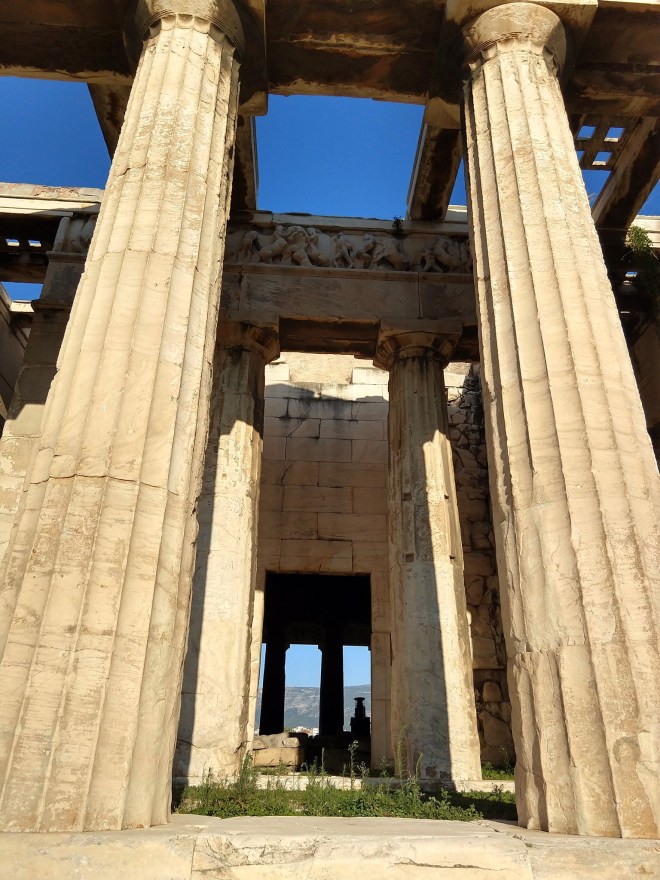
Final view of the Temple of Hephaestus through the center of it.
As we continued walking around the ancient agora, we eventually came to something called a “water clock.” I had never heard of such a thing, but apparently, this was a “clock” right in the middle of the agora. At the beginning of the day, it was filled with water and the design of the clock only allowed a certain amount of water to leak out at a time. As the day went on, the water level got lower, ultimately informing passerby’s what time it was in the day. Pretty nifty, eh? They actually had a similar system when it came to timing speeches during elections and in court hearings. A picture of one of the court clocks is farther down in this blog.
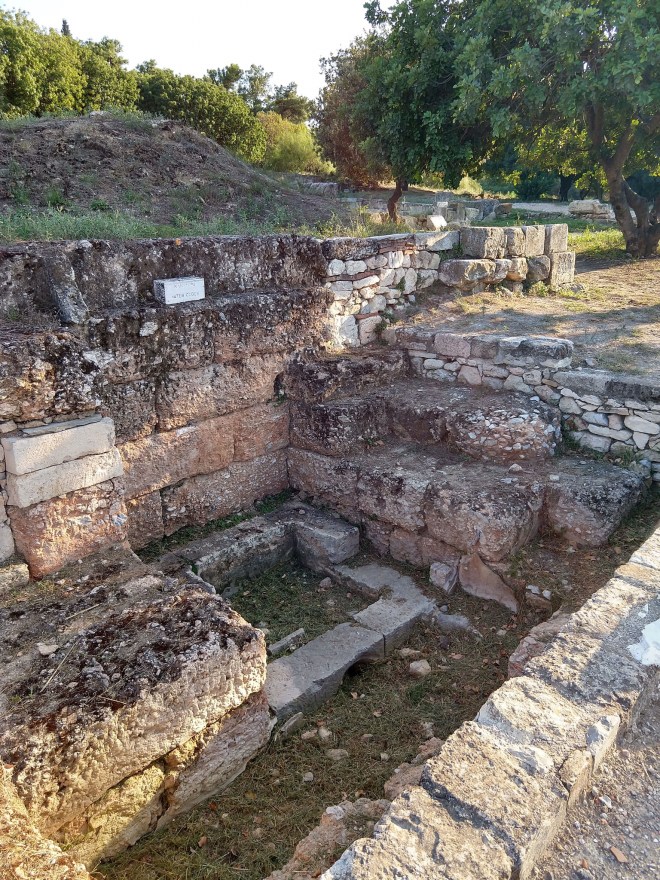
Ancient water clock
Near the ancient water clock we happened upon a fully intact church. I turned to Kirk and said – “That can’t be from the same time period, it looks too new.” As it turned out, I was right, while still being quite wrong! This tiny church was called The Church of the Apostles, and it was built around the year 1000 AD. Sure, this venue was built 1400 years later than everything else in this ancient agora, but what I had thought of as “new” was still 1000 years old! It’s funny how your perception of “old” changes in visiting new lands. At home, anything that is 100 years old is old!
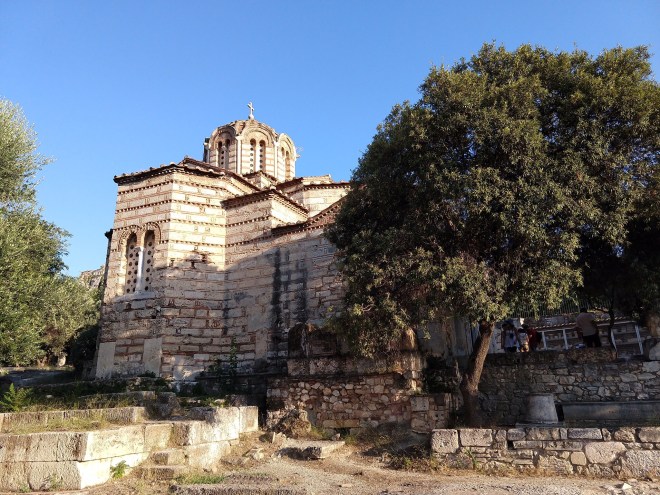
The outside of this “new” Church of the Apostles – butI around 1000 AD
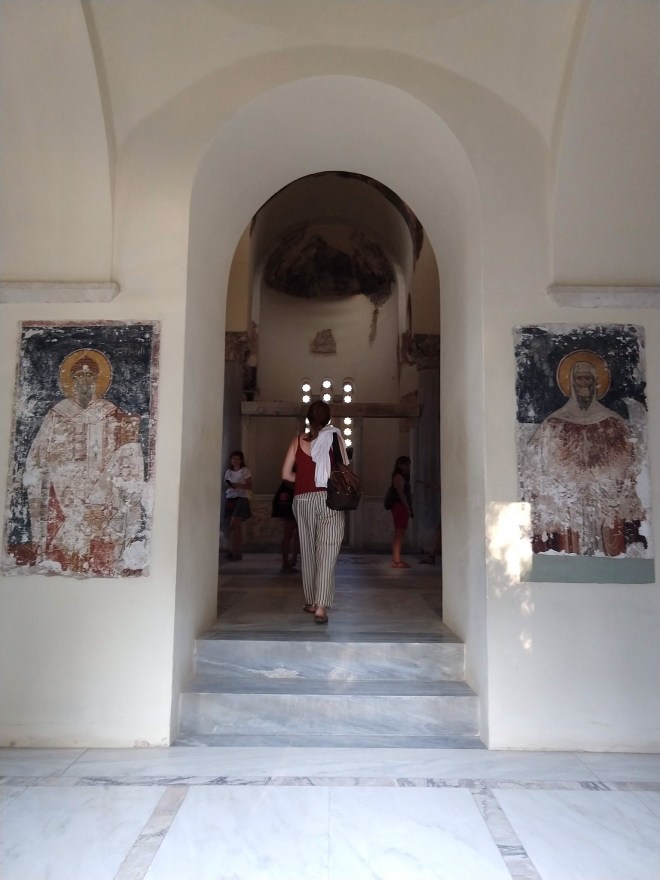
Walking into the Church of the Apostles

Dome of the Church of the Apostles
Our final stop inside the ancient agora was the agora museum. The museum itself is housed inside a replica of a humongous building that was once the marketplace in the ancient agora. Though most of the museum is filled with pottery and statues, there is a section of the museum that was of far greater interest to us – the one that demonstrated democracy in this ancient land.

The replica of the old marketplace building in which the modern day museum is housed. This was a huge building!
In the picture below are shards of pottery with names written on them. The plaque next to them reads:
“Ostracism was a unique type of voting intended as a means of protecting the city against aspirants to diplomatic power. The result of the ostracism vote was valid only if there was a quorum of 6000 present. Each voter scratched or painted on a potsherd the name of a man he thought most undesirable. The “candidate” with the greatest number of votes against him was obliged to withdraw from Athens for ten years.”
Isn’t that fascinating?? They voted to kick people out of the city to keep an individual from gaining too much power. It sounds a little cruel, but based on the Facebook posts I’m seeing, I’d bet there are a lot of people back home on both sides of the aisle wishing this tool was still in existence 😬 😂.

Pot shards with names on them, the plaque describing them to the right.

All these pot pieces have the same guy’s name on them – Themistocles was ostracized in 482 BC.
The next photo is an ancient piece of court/justice history in the realm of jury duty. The citizens of Athens who were eligible for jury duty carried bronze identification pieces on them. When it came time for jurors to be picked, their identification pieces were inserted randomly into the slab below. Next to this slab was a tube filled with bronze balls that were solid black or white in color. To select jurors, the tube of balls was cranked, and depending on whether a black or white ball came out, an entire horizontal row of names would be accepted or rejected for jury duty. One of these slabs stood at the entrance of every court.
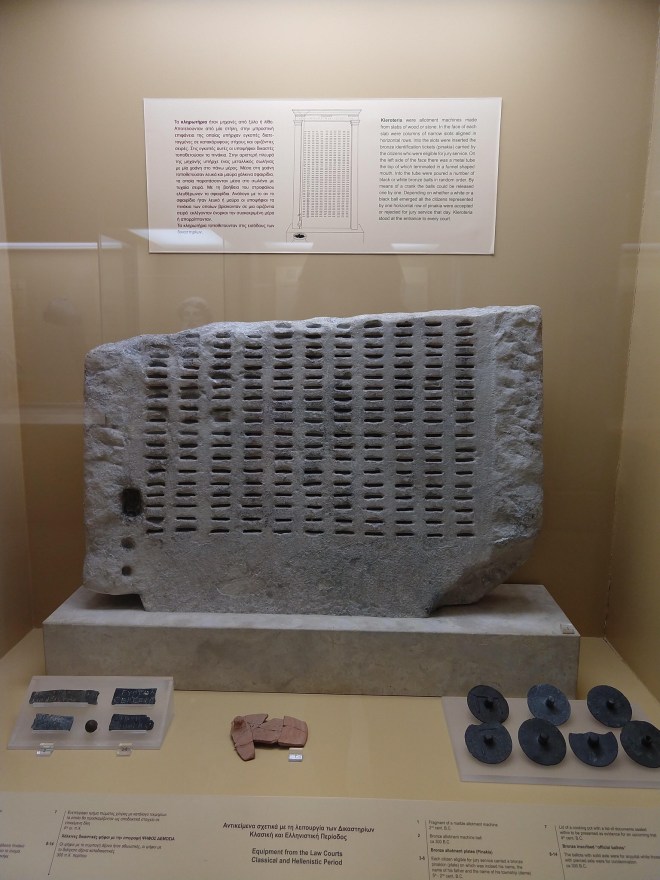
Kleroteria – jury duty selection slab
There was also a photo next to this jury duty slab of an old stone ballot box that they found. The actual box wasn’t in the museum, but it’s still pretty amazing to realize this stuff existed 2500 years ago!
Earlier I mentioned that there were also smaller water clocks that were used for court matters and political speeches. The smaller form of a water clock used for speeches in court is pictured below.

The top pot is an original water clock from 5th century BC, the bottom is a replica. The small hole on the top of the pot ensured that the water was filled to the same level each time. It took 6 minutes for the pot to drain.

A seat for a baby, which appears it could have doubled as some type of potty training seat – or perhaps there was just a hole in the bottom so that there was less mess to clean! I thought it was interesting that something like this existed that long ago either way!
On our final night in Athens, we took ourselves out for a nice dinner. We sought out a restaurant with a view of the Acropolis so that’d we have an opportunity to see it all lit up at night. We didn’t realize when we sat down what a treat we were in for!
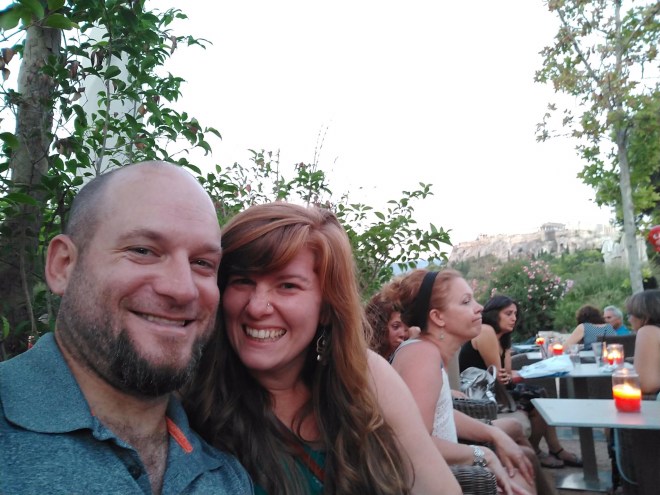
Us at dinner, Acropolis in the back.
I didn’t take pictures because it had gotten so dark but the time our food arrived, but we ordered a house made pumpkin ravioli in a brown butter Parmesan sauce and a roast lamb dish, which fell apart in the most tender way. Gah, both were so yummy! After spending the whole week trying to save money by eating gyros for $2 (which, by the way, were huge and also delicious!), this meal was a splurge at around $12 a plate. I wish we could find this stuff at home for those prices!
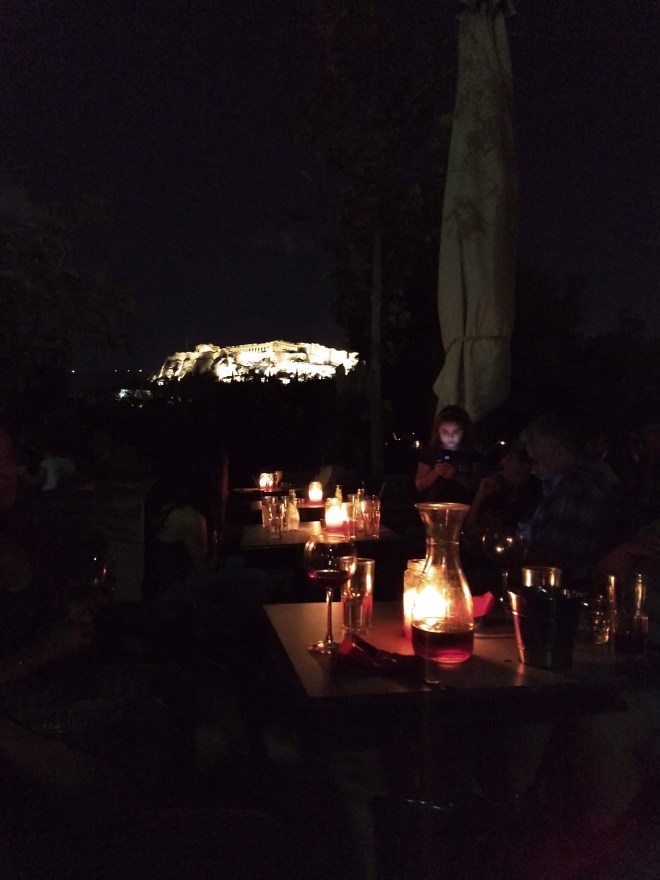
The Acropolis, all lit up.
The next morning a rental car was dropped off for us at our Airbnb apartment and we loaded up our things to begin our tour around the Greek Peloponnese. Knowing that we needed to not have to eat out every meal not he road, we went to the store and loaded up with groceries. Below is a picture of me with our car “cooler” 😂. Lots of bags with large frozen water bottles on top and bottom. Budget traveling requires recycling and resourcefulness 😂.
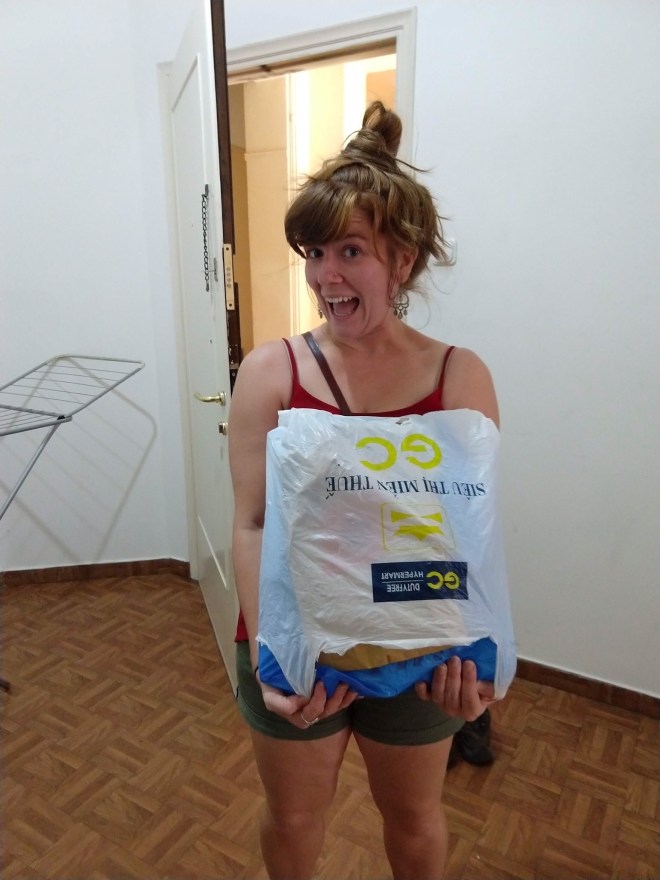
Stay tuned! The Greek Peloponnese was marvelous!
I think this is my favorite place that you’ve visited! Love the history and am amazed at the ancient architecture.
LikeLiked by 1 person